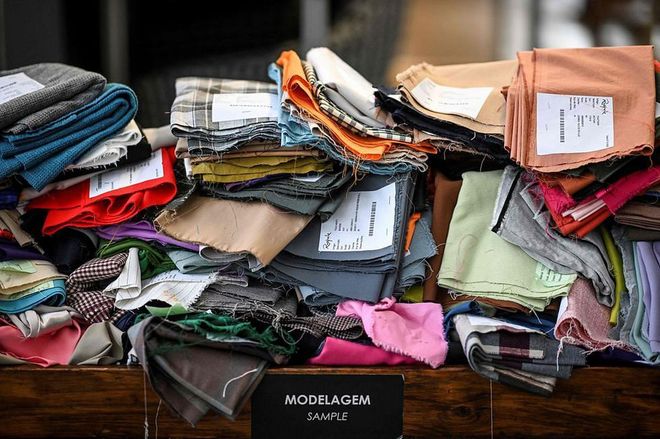Why Does Fast Fashion Fall Apart So Quickly?
Consumers care about clothing quality more than ever, and it’s never been worse.


Photo: EUROPA PRESS NEWS
Why Does Fast Fashion Fall Apart So Quickly?
Growing up in Biga, Turkey, on the soil where the ancient Trojan War was once fought, Volkan Yilmazwas surrounded by leather. His father, Irfan, ran a small tannery business, where young Volkan would trail behind him, taking notes on all the recipes and processes, nostrils filled with the pungent smell of corrosive chemicals and decaying flesh. By the age of 11, he had already learned how to tan his first sheepskin. Now, 25 years later, under the moniker Tanner Leatherstein, Yilmaz is parlaying his insight into leather into an addictive TikTok presence involving entertaining vivisections of designer leather bags. Yilmaz subjects Louis Vuitton, Bottega Veneta, and Coach accessories to a litany of abuse, slicing them open with an X-Acto knife, rubbing acetone on their surfaces, and lighting shreds on fire to determine the quality of the rawhide, finish, and tanning process. Once sufficient torture has occurred, he estimates the cost of leather and labor for the item, and leaves it up to the viewer to decide if the value is worth the market price.
Related article: Sydney Sweeney’s Stylist Is Here To Deliver Some Personal Style Tips
When it comes to purchasing a finished product off the rack, there’s the assumption that consumers get what they pay for. But increasingly, most clothing on the market is, simply put, no good. According to a viral tweet, “Most Gen Z consumers don't even know what quality fashion looks & feels like.” And while that may be a massive generalisation, it’s inarguably true that clothing quality has dropped precipitously over the past 30 years. A pair of jeans purchased at the Gap in 1995 was made of thick 100 percent cotton and constructed to withstand years of heavy wear. Now, the same pair of jeans costs $17 after multiple discounts, has added elastane, and is liable to fall apart after several washes. Clothing is the single category that has declined in price since 2000 in spite of egregious inflation elsewhere. But ironically, as good-quality clothing becomes hard and harder to find, it’s becoming increasingly important to a growing cohort of consumers.
“[I think a lot of people my age are wondering] why our clothes aren’t lasting as long and why [we] have to replenish everything so quickly,” Kira Mungai, a 22-year-old receptionist based in Seattle, says. Mungai is on the vanguard of a small cohort of Gen Z consumers that prioritize superior craftsmanship, natural materials, and conscious consumption over mammoth Shein hauls. Twenty years ago, when fast fashion became commonplace, the novelty of being able to afford a new winter coat every year was irresistible. But as manufacturers cut corners on fabric quality and labor in order to keep costs down and the end product suffers, now all anyone wants to buy is a winter coat that lasts.
“I love raiding my mom’s closet, because she keeps all her clothes in such good condition, whereas mine will break quite easily,” Maya Hall, an 18-year-old political science major at the University of Oregon in Eugene, says. “From freshman to junior year of high school, I was big on buying PacSun jeans, but I would have to buy the same pair [pretty] often, because they would shrink really fast and looked demolished just from me walking around in them.” Hall loves her mom’s vintage Levi’s that hail from the 2000s, because they’re a thicker, more durable material than what she’s used to, and stay true to size after a wash.

Several fabric samples at a textile factory in Vila Nova de Famalicao, Portugal. Photo: PATRICIA DE MELO MOREIRA
Why Does Fast Fashion Fall Apart So Quickly?
According to Keri Inge-Marshall, a 21-year-old creative writing major at Columbia College in Chicago, much of her generation’s knowledge of clothing quality has taken place incidentally. Either they dip into their parents’ closets like Hall, or they head to the thrift store looking for vintage treasures and realise that the cute Y2K-era clothing—even the cheap stuff—lasts longer than anything they’ve ever bought new.
“Quality is the most underrated, least-talked-about aspect of sustainable fashion,” says Andrea Cheong, whose TikToks eviscerating the quality of mall brands serve to educate consumers on what aspects of construction make an item of clothing last. Cheong is perhaps the most visible of a new class of content creators, including Tanner Leatherstein and Derek Guy, the notorious “menswear guy” on Twitter who’s pendantic threads on the origins of cashmere goat hair regularly go viral, helping people relearn that there’s a lot more to clothing than just how it looks.
Related article: Sustainable Menswear Brands That Sell Essential Basics Every Man Needs
“Our relationship with fashion has become so surface level, and I think people are just sick of it,” Cheong says. “I always tell people you should choose your clothes like you choose your friends. If they’re not as beautiful on the inside as they are on the outside, why are you wasting your time?” When shopping in person, she advises turning clothing inside out to look for loose threads, ensuring buttons are securely attached, and reading the labels to understand the composition of materials. For online shopping, she says to zoom in on the pictures of the garment to make sure everything looks right. “Most of us innately have a sense of what looks right or not, but we don’t necessarily have the terminology or foundation or basic knowledge to be able to explain why,” she says. And people are taking note; her videos regularly garner comments like, “This has completely changed my approach to shopping.”
This renewed desire for quality comes from a frustration with the options available, but also out of necessity. Thanks to the cost-of-living crisis, people can no longer afford to shop with abandon like they once did. When the cost of a carton of eggs has risen by 70 percent in a single year, a $100 monthly Shein haul becomes, for many households, out of the question.
The refusal to buy products of diminishing quality remains one small yet poignant form of resistance
“There’s this idea that when it comes to cheaper brands like Shein and Forever 21, they’re making clothes for poor people,” Lakyn Carlton, a personal stylist and sustainable fashion expert based in Los Angeles, says. “No, they’re not. They’re doing it so they can make as much money off you as possible, even with your limited income.”
Realistically, the ability to afford quality has always been dictated by income. “There’s always been a clear divide between brands that care for quality and brands that do not,” Carlton says. But now that anyone can purchase stylish clothing on a whim with a limited budget, it’s led to not only an overproduction crisis, but a completely ahistorical sense of entitlement in regard to what we put on our bodies. When clothing was less affordable, one simply had to wear what they owned until it wore out, regardless of whether it was fashionable or not—a concept so basic it now passes for wisdom in the field of sustainable fashion. The reality is that all clothing involves skilled labor to produce, and it shouldn’t be so easy to acquire and discard.
Collectively, the less satisfied consumers are with crap, the more companies will have to offer something good again. Yilmaz predicts that over time, bigger brands will lose market share to smaller craftsmen because, “Gen Z couldn’t care less about marketing fluff.”
Cheong is hopeful that her industry watchdog videos are being seen by people with enough power to influence the quality of clothing production at major brands. “We’re very much in the beginning of, ‘This girl won’t shut up; she’s been around a while now, and now we’ve got to listen,’” she says.
Others are more skeptical. “Overall, it's a good thing for people to start thinking about the quality of their clothes, but given the way fashion operates, it’s going to take a lot more than that [to make a difference,” Carlton says.
Related article: Cate Blanchett Champions Sustainable Fashion At The Independent Spirit Awards
Though it's still far too early to tell how this will play out, the refusal to buy products of diminishing quality remains one small yet poignant form of resistance, a way of maintaining one’s dignity amid a marketplace that expects—and depends—on you to accept the conditions you’re given.
Perhaps when it comes to acquiring clothing, it’s wise to keep in mind the old adage: A fool and his money are often parted. By educating ourselves about what good-quality clothing should be, we're less likely to play the fool.
This article originally appeared in Harper’s BAZAAR US.